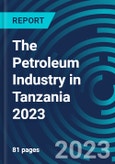Introduction
The Tanzanian petroleum industry has been growing in terms of natural gas output and the consumption of natural gas and petroleum products. Tanzania has the fifth-largest recoverable natural gas reserves and it produces enough natural gas to satisfy domestic demand. The country’s 23 petroleum product receiving terminals at its ports have a combined storage capacity equivalent to 122 days of consumption. Tanzania is an important channel for neighbouring landlocked countries’ petroleum imports. Opportunities to grow the industry include planned natural gas pipelines to Kenya and Zambia and the Tanzania Liquefied Natural Gas project, which will be the country’s largest investment to date.Opportunities
Increasing consumption of LPG due to a campaign run by the government and wholesalers to promote the use of LPG to replace charcoal, firewood and kerosene, as LPG is a healthier and more environmentally friendly fuel.Increasing consumption of natural gas and petroleum products due to economic growth. Planned natural gas pipelines to Kenya and Zambia. The Planned Tanzania Liquefied Natural Gas Project. There is scope to increase natural gas production due to the availability of spare processing and distribution capacity. Vehicle owners switching to using compressed natural gas due to high petrol prices.
Outlook
Global crude oil and natural gas production and consumption are forecast to increase. After 2022’s high prices due to the Russia-Ukraine war, the oil price is expected to decrease as oil supplies normalise and production exceeds consumption in 2024. The demand for petroleum products in Tanzania is expected to grow due to economic growth and the expansion of the road network. The consumption of natural gas in Tanzania is expected to rise due to increased usage in houses, for power generation and industrial heating, and as compressed natural gas for powering vehicles. The country has the opportunity to export gas to neighbouring countries via pipelines.The Tanzania Liquefied Natural Gas Project is expected to boost the country’s economy during the construction and operational phases. Global demand for LNG is forecast to grow over the next 20 years, with consumption expected to exceed supply towards the end of the 2020s, when this project is expected to enter production.
Report Coverage
This report on the petroleum industry in Tanzania provides comprehensive information on crude oil and natural gas, petroleum products, fuel wholesale and retail, exploration, reserves, pipelines and major new projects.There are profiles of 19 companies including state-owned Tanzania Petroleum Development Corporation, major international players such as TotalEnergies and Shell and gas companies including Songas and Taifa Gas.
Strengths
Established infrastructure and supply chains for the production and distribution of natural gas and the importation of petroleum products.Large natural gas reserves. Petroleum importers are well-established. The natural gas industry is well-established.
Threats
A global campaign called Stop EACOP is trying to halt the East African Crude Oil Pipeline project.Weaknesses
Some petrol stations at times do not have stock of a specific fuel due to delays in deliveries or a lack of funds to ensure sufficient stock is always available, mostly in the case of independent petrol stations. There is a shortage of compressed natural gas (CNG) filling stations, as increasing numbers of vehicle owners want to switch from petrol to CNG. Very few people in Tanzania have the qualifications and skills required by companies in the industry.Table of Contents
1. INTRODUCTION2. COUNTRY PROFILE5. AFRICA6. INTERNATIONAL9. SWOT ANALYSIS10. OUTLOOK11. INDUSTRY ASSOCIATIONS
3. DESCRIPTION OF THE INDUSTRY
4. LOCAL
7. INFLUENCING FACTORS
8. COMPETITIVE ENVIRONMENT
12. REFERENCES
APPENdix
COMPANY PROFILES
Companies Mentioned
- TotalEnergies Marketing Tanzania Ltd
Methodology

LOADING...








